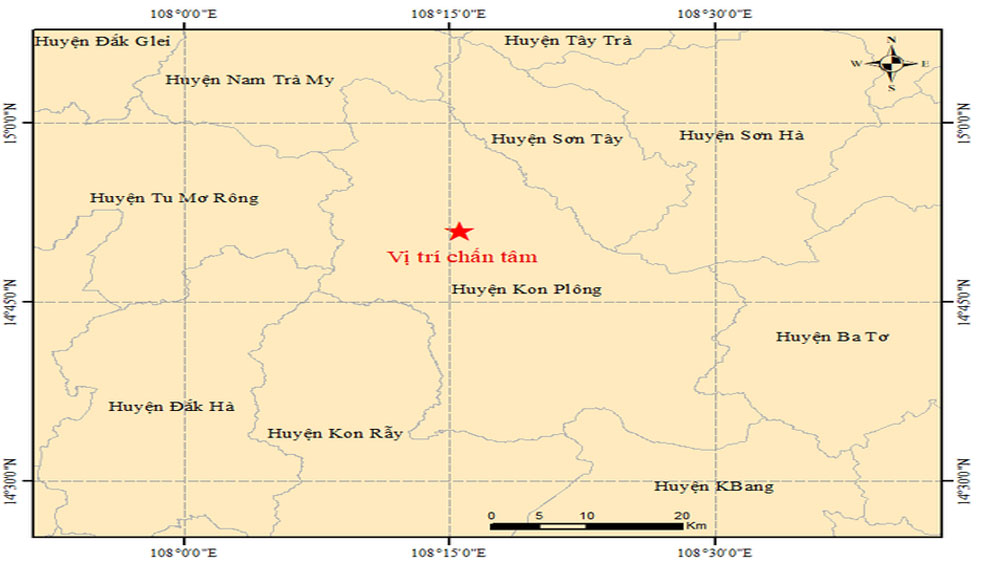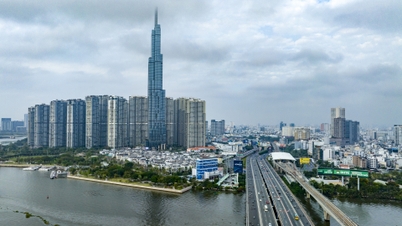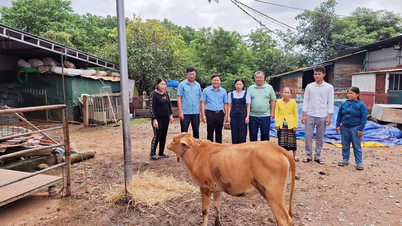In less than ten hours on July 7, in Kon Plông district, there were 12 earthquakes causing aftershocks ranging from 2.5 to 4.2 magnitude, according to the Institute of Geophysics.
 |
The epicenter of the 4.2 magnitude earthquake on the morning of July 7. Source: Earthquake Information and Tsunami Warning Center |
The first earthquake occurred at 9:31 am, with a magnitude of 3.9, at a depth of about 8.1 km. After that, 11 other earthquakes occurred consecutively with different intensities, ranging from 2.5 to 4.2. The most recent earthquake was recorded at 7:56 pm with a magnitude of 2.5 and a depth of about 8.1 km. Currently, the Earthquake Information and Tsunami Warning Center - Institute of Geophysics continues to monitor these earthquakes.
Dr. Nguyen Xuan Anh, Director of the Institute of Geophysics, said it was a stimulated earthquake, caused by the hydroelectric reservoir storing water.
In August 2022, 12 earthquakes occurred in two consecutive days. According to Dr. Xuan Anh, this recurring phenomenon shows that "triggered earthquakes also occur cyclically. There are times when earthquakes occur in a chain, and there are times when there are only a few, closely related to the water storage operation of the hydroelectric reservoir," he said. Compared to the previous few days, the number of recorded earthquakes is clearly higher, but still within the chain of triggered earthquakes and in the weak earthquake range. Therefore, the maximum earthquake in the area does not exceed 5.5 magnitude.
Mr. Xuan Anh said that we still need to continue monitoring earthquake activity to detect any abnormalities and notify people to reassure them. There have been no reports of human casualties.
Previously, Associate Professor Dr. Nguyen Hong Phuong, a seismologist at the Institute of Geophysics, shared that the cause of induced earthquakes is understood to be due to human impact on nature, not natural earthquakes like in the northern regions, due to natural fault zones.
According to Associate Professor Phuong, induced earthquakes have an easy-to-understand rule, mostly occurring in areas with active reservoirs, especially hydroelectric reservoirs or large reservoirs. When the reservoir is filled with water, the amount of water causes great pressure on the bottom of the reservoir, combined with local faults (even small), increasing the stress of the large water column will cause induced earthquakes.
The induced earthquakes are usually cyclical, occurring after the water accumulation period and the rainy season. Once they reach a certain peak, they will start to gradually decrease, forming a series of medium and medium earthquakes, then gradually die down. "The time to die down will need to be studied, depending on the local monitoring stations, because in different regions the cycle will be different," he said.
According to experts, the earthquake in Kon Plong, the construction site of the Upper Kon Tum hydropower plant, has something in common with the phenomenon at the Song Tranh 2 hydropower dam in Quang Nam - both are induced earthquakes, occurring in the reservoir area. When hydropower plants operate, they increase stress, causing pressure on the ground, leading to slippage and causing earthquakes.
In March 2021, the Upper Kon Tum Hydropower Plant stored water to generate electricity. Since April 2021, earthquakes have occurred continuously in Kon Plong and neighboring districts, and the frequency of the earthquakes has also increased dramatically since then.
Statistics show that in 117 years, from 1903 to 2020, the Kon Plong area recorded only about 33 earthquakes, from 2.5 magnitude and above. However, from 2021 to now, there have been over 200 new earthquakes. Experts all say that it is very difficult to predict exactly when an earthquake will occur.
According to VnExpress
12 consecutive earthquakes, earthquakes in Kon Tum, Kon Plong district
Source link



![[Photo] Prime Minister Pham Minh Chinh receives Lao Minister of Labor and Welfare Phosay Sayasone](https://vphoto.vietnam.vn/thumb/1200x675/vietnam/resource/IMAGE/2025/11/11/1762872028311_dsc-2246-jpg.webp)
































































































![Dong Nai OCOP transition: [Article 3] Linking tourism with OCOP product consumption](https://vphoto.vietnam.vn/thumb/402x226/vietnam/resource/IMAGE/2025/11/10/1762739199309_1324-2740-7_n-162543_981.jpeg)








Comment (0)